A new sight is coming to South Florida. Terra Development will be starting its new development of Upland Park after securing a $170 million construction loan from Slate Property Group for phase 1. The $1 Billion project is set to begin in early 2025, with a formal groundbreaking ceremony. This will mark the start of Miami-Dade County’s largest public-private transit-orientated project in history.
Dual Purpose
The project is set to feature both residential and commercial spaces with phase 1 consisting of 578 apartments. Terra has partnered with PPK Architects, Arquitectonica and Plusurbia Design in order to create 2,000 garden-style and mid-rise apartments. In addition, the project’s 47 acres will also feature 282,000 square feet of retail space and 414,000 square feet of other commercial space.
Why Upland Park
Upland Park was created in order to support Miami-Dade County’s SMART plan. The SMART plan is a large-scale initiative with the purpose of expanding the public transit system to increase the connection within the county. Upland Park will be placed strategically in the East-West Corridor promoting its public transportation by offering a center for housing, retail and commercial spaces. The county hopes to fight its problem of traffic congestion and limit private vehicles. In addition, Upland Park is expected to create thousands of jobs and generate tremendous amounts of revenue.
Upland’s Future
Phase 1 of the project is expected to be completed by the second quarter of 2025, with the construction of residential area. With the timeline of phase 2 undeclared, it can be expected that the Upland Project will not be completed for the next few years.
Sources:
rebusinessonline.com/terra-obtains-170m-construction-loan-for-first-phase-of-1b-upland-park-mixed-use-project-in-south-florida/
www.terragroup.com/property/upland-park/
www.multihousingnews.com/terra-lands-construction-loan-for-1b-miami-project/

Samantha Brinkerhoff is the Marketing Specialist for Cohen Commercial.



